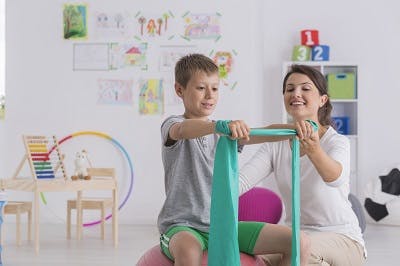If your loved one has cerebral palsy, it’s essential to understand how the condition may affect one’s posture.
Postural control is the ability to control the body’s position in space to obtain stability and orientation. This skill is fundamental to every movement we make. As a result, when individuals have poor postural control, a variety of other motor functions may be affected.
To help you understand the link between cerebral palsy and posture, this article will discuss:
- How Cerebral Palsy Affects Posture
- Early Signs of Compromised Posture in Individuals with CP
- Risks Associated with Poorly Managed Posture
- How to Manage Compromised Posture Due to Cerebral Palsy
How Cerebral Palsy Affects Posture
The primary causes of compromised posture in individuals with CP are abnormal muscle tone and muscle imbalances.
Individuals with cerebral palsy may experience high or low muscle tone, or a mix of both. Having too much or too little tone may make it challenging to control movements and maintain posture.
For example, low muscle tone in the trunk may make it challenging to maintain sitting balance. Consequently, individuals with poor trunk stability may start to lean to one side.
Similarly, high muscle tone may pull the body into abnormal postures. The longer an individual remains in a specific posture, the greater their risk of developing contractures. The body becomes accustomed to consistently compromised posture, which may contribute to the development of long-term postural abnormalities.
While postural abnormalities are generally not present at birth, they typically become more prominent with age. Often, trunk deformity becomes noticeable around 7 years of age. Likewise, those with more severe motor impairments are more likely to experience postural abnormalities.
Cerebral palsy is a developmental motor disability and compromised posture significantly affects growth and development. Therefore, it’s essential to seek early intervention for postural abnormalities. Next, we’ll explain early signs of compromised posture due to CP.
Early Signs of Compromised Posture in Individuals with CP

Because individuals with cerebral palsy have an increased risk of developing abnormal posture, early identification and intervention are essential.
Early signs of posture problems may include:
- High or low muscle tone in the trunk
- Difficulty keeping the head upright
- Leaning
- Tilted pelvis
- Rounded shoulders
- Bent knees while standing
If your child exhibits any of these signs, consult with their pediatrician. In the following section, we’ll provide education on the risks associated with compromised posture in individuals with CP.
Risks Associated with Poor Posture in Individuals with Cerebral Palsy
Compromised posture due to cerebral palsy may lead to a wide range of other motor impairments.
Individuals with poorly managed posture due to CP generally have an increased risk of:
- Pain
- Scoliosis
- Breathing difficulties
- Cardiac problems
- Poor balance
- Further mobility restrictions
- Uneven growth
- Hip subluxation/ dislocation
Musculoskeletal imbalances place excess strain on the bones and joints. As a result, poorly managed posture may ultimately compromise function.
In the following section, we’ll provide management interventions that may reduce the progression of posture abnormalities.
How to Manage Compromised Posture

Treatment for postural abnormalities in individuals with cerebral palsy generally focuses on improving one’s functional abilities and prevent additional posture imbalance.
If not properly managed, posture may be compromised at any age. Cerebral palsy is a lifelong condition, and while the brain damage that caused it will not progress, symptoms such as abnormal muscle tone may continue to cause problems.
Some interventions to manage and improve posture include:
- Spasticity management. Because abnormal muscle tone is the primary cause of poor posture, targeting spasticity may relax the muscles and reduce muscle imbalances. Spasticity management typically consists of medications that temporarily reduce muscle tone (Botox, baclofen, etc.) followed by intensive physical training.
- Physical therapy. Physical therapy involves practicing exercises that target underused muscles, gentle stretching of tight muscles, and increasing functional range of motion. This may reduce musculoskeletal strain and improve postural control.
- Orthotics. Wearing a trunk brace often stabilizes the spine in an upright position and delays surgery.
- Wheelchair modifications. A seat mold for wheelchairs provides trunk stability and prevents leaning to one side.
- Compression suits. Compression suits may be an effective alternative to braces. Additionally, they provide consistent pressure to the body, which supports improved circulation and stimulates the sensory nerves.
- Hippotherapy. Consistently engaging the core is essential to improving posture and stability. Hippotherapy is an exciting form of Physical therapy that involves horseback riding. It is a multi-sensory experience that is proven to improve sitting balance, standing balance, and postural control.
- Functional electrical stimulation. Functional electrical stimulation involves placing electrode arrays on the skin to stimulate neuronal activity. Studies [1],[2] on individuals with cerebral palsy demonstrate that FES along with rehabilitation improved postural alignment to a greater extent than rehabilitation alone.
- Surgery. More severe posture problems usually require surgery. For example, individuals with scoliosis may need spinal fusion surgery, which involves using metal rods, screws, and hooks to fuse the spine together and promote improved spinal alignment.
Depending on the severity of one’s postural abnormalities, treatment interventions vary. Ultimately, the earlier posture problems are treated, the more effective non-invasive options will be.
Cerebral Palsy and Posture: Key Points
Cerebral palsy is a motor disability that can significantly affect one’s posture. Fortunately, there are many effective ways to prevent a decline in posture and optimize motor functions to improve your quality of life.
We hope this article helped you understand how cerebral palsy may affect posture as well as how to promote better postural control and stability.











